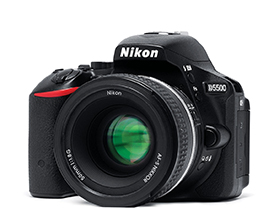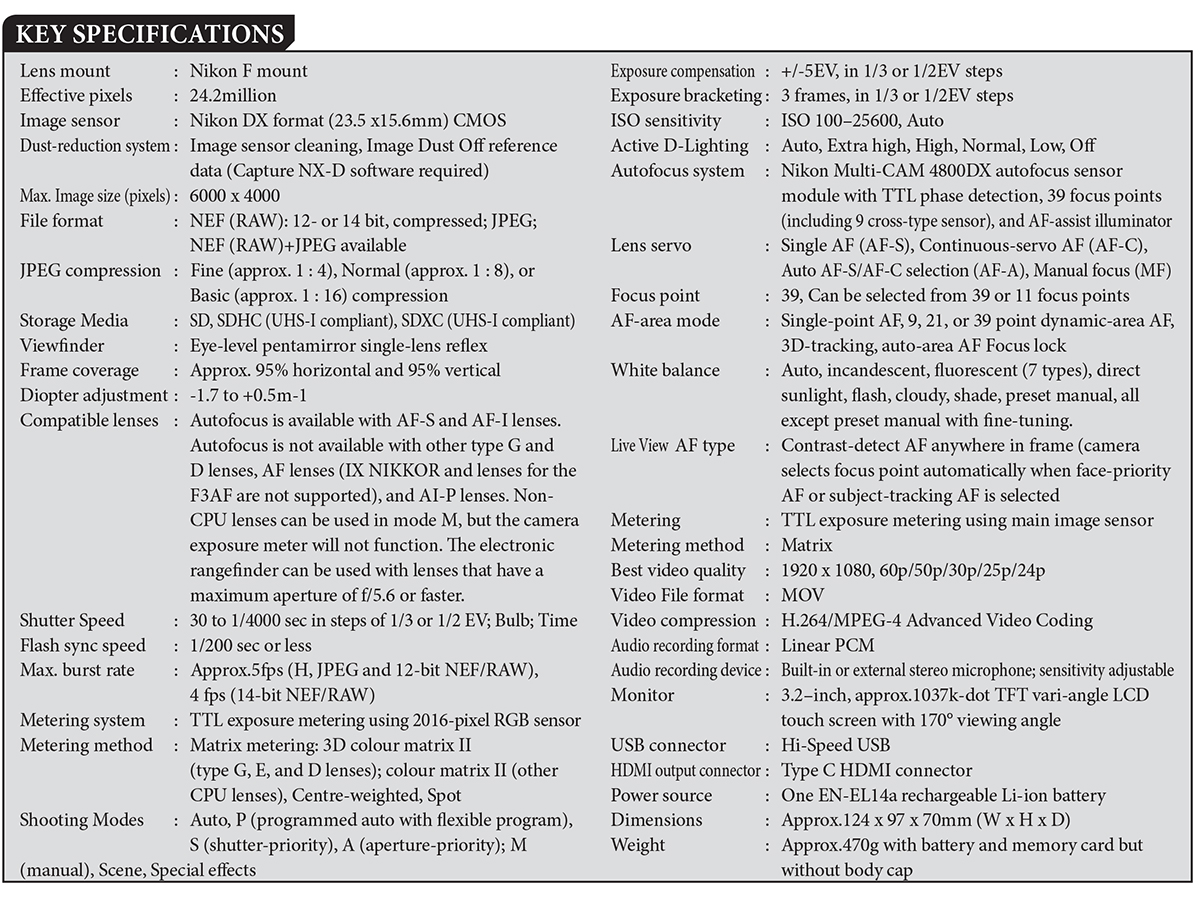 Minor upgrades usually come with a small jump in model numbers, yet the Nikon D5500 seems to be a minor upgrade with the camera inheriting its most important features from the D5300. This 24.2 megapixel model boasts a touchscreen monitor and better hand grip.
Minor upgrades usually come with a small jump in model numbers, yet the Nikon D5500 seems to be a minor upgrade with the camera inheriting its most important features from the D5300. This 24.2 megapixel model boasts a touchscreen monitor and better hand grip.
Design and Build Quality
Th e D5500 is built with sturdy polycarbonate material. The camera has changes in design compared to the D5300, especially the grip. The body has been made more compact and the grip thinner and deeper. The LCD swivels and rotates, as in the case of the D5300, making it easy to take self-portraits in addition to high and low-angle shots. This also protects the screen from accidental damage. Nikon has redesigned the command dial. The dial now rests in a slot on the top panel by the side of the mode dial instead of the one partially visible near the thumb rest. This has also left more room for the thumb rest. Both the lens mount and tripod receptacle are made of metal.
Key Features
The 24.2 megapixel Nikon D5500 uses a Nikon DX format (23.5 x15.6mm) CMOS sensor. The camera does not have an Optical Low-Pass Filter (OLPF). The 5500’s dust-reduction system uses ultrasonic sensor cleaning along with Image Dust Off Reference Data (requires Capture NX-D soft ware) to reduce dust and eliminate dust bunnies in the image. The D5500 does not feature an in-body AF motor, and hence autofocus is available only with AF-S and AF-I lenses which have AF motors inside. Non-CPU lenses can be used in Manual mode, but the exposure meter will not function. The electronic rangefi nder can be used with lenses that have a maximum aperture of f/5.6 or faster. The 5500 features a Type B BriteView Clear Matte Mark VII focussing screen. In normal view (not using Live View), the camera uses Nikon Multi-CAM 4800DX autofocus sensor module with TTL phase detection. This system uses 39 focus points including nine cross-type sensors (the crosstype sensors can detect vertical and horizontal patterns, unlike the rest of the sensors, which are oriented in one direction and hence can detect patterns only along a single direction). You can select either 39 or 11 focus points depending on the situation. Lens servo options are Single AF (AF-S), Continuous-servo AF (AF-C), Auto AF-S/AF-C selection (AF-A), and Manual focus (MF). AF-area modes include Single-point AF, 9, 21, or 39 point dynamic-area AF, 3D-tracking, and auto-area AF.
Still images are recorded in NEF (Raw): 12- or 14 bit, or JPEG format, with the option to record both simultaneously. JPEG images can be recorded in Fine (approx. 1 : 4), Normal (approx. 1 : 8), or Basic (approx. 1 : 16) compressions. The maximum size of images is 6000 x 4000 pixels. You can adjust the colour, contrast, brightness, and sharpness of images using the Picture Control menu. Pre-set options include Standard, Neutral, Vivid, Monochrome, Portrait, Landscape, and Flat (this mode will preserve the dynamic range). The values can be modifi ed and saved.
The camera sports an electronically-controlled verticaltravel focal plane shutter, providing shutter speeds from 30 to 1/4000 sec. with options for Bulb and Time. The shutter synchronises with flash at 1/200 sec or lower speeds. Drive modes include S (single frame), CL (continuous low speed), CH (continuous high speed), Q (quiet shutter-release), Self-timer, Interval timer, and Delayed remote. The D5500 can shoot continuous bursts at up to 5 fps (JPEG High and 12-bit NEF/ RAW) or 4 fps (14-bit NEF/RAW). Self-timer provides options of 2, 5, 10, or 20 sec for 1 to 9 exposures.
The D5500 uses TTL exposure metering using 2016-pixel RGB sensor. Metering modes include Matrix (3D Colour Matrix Metering II with type G, E, and D lenses; Colour Matrix Metering II with other CPU lenses), Centreweighted (Weight of 75% given to 8-mm circle in centre of frame), and Spot (3.5-mm circle centred on selected focus point). Exposure can be compensated up to +/-5EV in 1/3 or 1/2 EV steps. Exposure bracketing is available for 3 frames in 1/3 or 1/2EV steps. ISO sensitivity ranges from ISO 100 to 25,600 along with an Auto option. Active D-Lighting is available, with options of Auto, Extra high, High, Normal, Low, and Off. White Balance options are Auto, Incandescent, Fluorescent (7 types), Sunlight, Flash, Cloudy, Shade, and Preset manual. These settings can be fine-tuned to eliminate any residual colour cast. White Balance can be bracketed for 3 shots. Shooting modes available are Auto, P (programmed auto with flexible program), S (shutterpriority auto), A (aperture-priority auto), M (manual), Scene, and Special effects. Scene modes include Portrait, Landscape, Child, Sports, Close up, Night portrait, Night landscape, Party/Indoor, Beach/Snow, Sunset, Dusk/Dawn, Pet Portrait, Candlelight, Blossom, Autumn Colours, and Food. Special Effects modes are Night vision, Super vivid, Pop, Photo illustration, Toy camera effect, Miniature effect, Selective colour, Silhouette, High key, and Low key.
The built-in flash has a Guide Number of 12m at ISO 100. Flash is controlled by TTL method, and is fully compatible with i-TTL flash control. Flash modes available are Auto, Auto with red-eye reduction, Auto slow sync, Auto slow sync with red-eye reduction, Fill-flash, Red-eye reduction, Slow sync, Slow sync with red-eye reduction, Rear-curtain with slow sync, Rear-curtain sync, and Off. Flash intensity can be compensated from -3 to +1 EV in steps of 1/3 or 1/2 EV. The camera also sports a standard ISO 518 accessory shoe with sync and data contacts and safety lock. The D5500 supports Advanced Wireless Lighting with SB-910, SB-900, SB-800, SB-700, or SB-500 Speedlites as a master flash or SU-800 as commander.
The camera has an eye-level pentamirror single-lens reflex viewfinder with approx. 95% frame coverage. The 5500 also features Live View shooting. During Live View, the camera uses Facepriority, Wide-area, Normal-area, and Subject-tracking autofocus modes. It uses Contrast-detect AF method, and the camera selects the focus point automatically when face-priority AF or subjecttracking AF is selected. Videos are recorded at the best quality of 1920 x 1080 at 60p, 50p, 30p, 25p or 24p in MOV format (H.264/ MPEG-4 Advanced Video Coding with Linear PCM audio). The camera has a built-in stereo microphone with adjustable sensitivity and provides option for an external microphone.
The D5500 uses a 3.2–inch, approx.1037k-dot TFT vari-angle LCD with touch screen and 170° viewing angle. The camera accepts an SD, SDHC, SDXC (UHS-I compliant) card for storage. Interface connectors include Hi-Speed USB, Type C HDMI connector, Stereo mini-pin jack (3.5 mm diameter), and accessory terminal to connect optional accessories such as wireless remote controllers (WR-1, WR-R10), remote cord (MC-DC2), and GPS units (GP-1/GP-1A). The ISO 200 ISO 3200 ISO 12800 ISO 800 ISO 6400 ISO 25600 NOISE the AF-S Nikkor 50mm f/1.8G lens. The combination performed well in our tests. Autofocus was fast and precise with lens focussing even under low light. We observed very slight darkening of corners at f/1.8, though barely noticeable. Images were sharp and the sweet spot was found to be f/8. F/5.6 and f/11 also provided good sharpness. We did not observe any distortion in the images. All metering modes performed very well. Auto White Balance performed very well. Though we observed slight cast under some lighting conditions, these were easily removable in postprocessing. Native print size was 20 x 13.33 inches at 300 ppi. At 25 percent of screen size, we observed a tinge of noise at ISO 6400, but the images were perfectly usable up to ISO 12,800. ISO 25,600 was very noisy. Viewed at 50 percent, noise appeared from ISO 3200, but the images were usable up to ISO 6400. Enlarged camera is powered by an ENEL14a rechargeable Li-ion battery. The D5500 has dimensions of approximately 124 x 97 x 70mm (W x H x D) and weighs approximately 470g with battery and memory card but without body cap.
 Ergonomics
Ergonomics
The D5500 is light and easy to carry around. The buttons are very small, and there are not many shortcut (function) buttons on the camera. This makes it difficult to change the settings. We are still not convinced about the utility of a touch interface in a D-SLR, that too without enough customisable function buttons. The camera has a tiny drive mode button on the neck of the lens mount, which is not very easy to operate. This could possibly have been done to avoid accidental changes. Images in the LCD appeared crisp and clear.
Performance
We received the D5500 along with the AF-S Nikkor 50mm f/1.8G lens. The combination performed well in our tests. Autofocus was fast and precise with lens focussing even under low light. We observed very slight darkening of corners at f/1.8, though barely noticeable. Images were sharp and the sweet spot was found to be f/8. F/5.6 and f/11 also provided good sharpness. We did not observe any distortion in the images. All metering modes performed very well.
Auto White Balance performed very well. Though we observed slight cast under some lighting conditions, these were easily removable in postprocessing. Native print size was 20 x 13.33 inches at 300 ppi. At 25 percent of screen size, we observed a tinge of noise at ISO 6400, but the images were perfectly usable up to ISO 12,800. ISO 25,600 was very noisy. Viewed at 50 percent, noise appeared from ISO 3200, but the images were usable up to ISO 6400. Enlarged to 100 percent, the images showed slight noise from ISO 800, but was perfectly usable up to ISO 3200.
The videos were smooth with good sound quality.
On the flip side, the lens produced heavy flare and purple fringing.
Value for Money
The D5500 body retails at an MRP of Rs. 54,450. The D5300 was launched a year ago at the same price, though currently it is priced at Rs.49,450. At the current levels, the D5300 would be a better buy, but wait for a few months and the 5500’s price could fall.

PLUS
• Good noise control
• Better grip
• Fully articulated LCD
MINUS
• Not many shortcut buttons
• No built-in GPS
• Buttons are tiny
FINAL SCORE 82%
Design and Build Quality 16/20
Key Features 18/20
Ergonomics 16/20
Performance
Autofocus 4/5
Metering 5/5
Noise Control 4/5
Sharpness 4/5
LCD/EVF 5/5
Auto W/B 3/5
Sub-Total 25/30
Value for Money 7/10
VERDICT
Though Nikon has skipped one number in the series for this upgrade (theoretically, this had to be named as D5400), the camera is a minor upgrade to the 5300. The 5500 features a touch screen interface, but loses built-in GPS. There is subtle improvement in noise control, but this is not reason enough to upgrade from the D5300.
Sujith Gopinath

